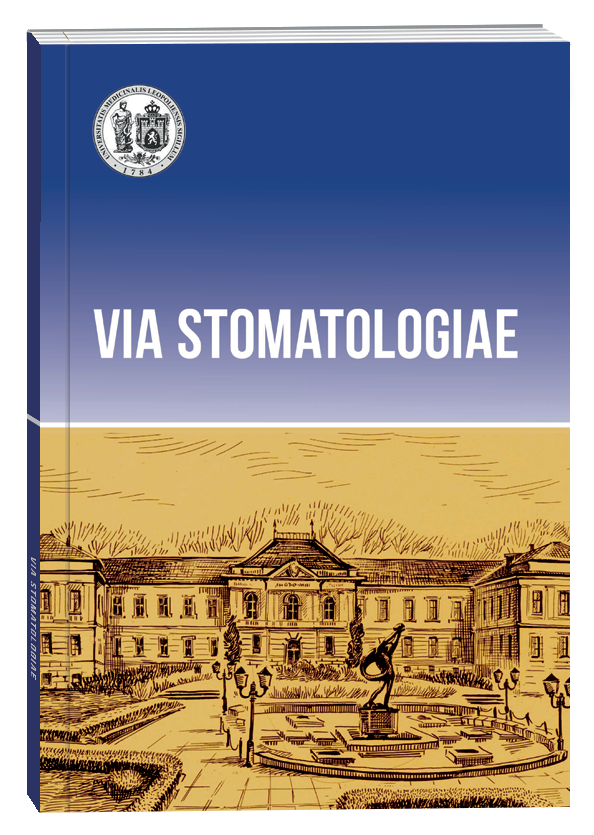THE IMPACT OF ORAL HYGIENE ON PERI-IMPLANT HEALTH
DOI:
https://doi.org/10.32782/3041-1394.2024-1.4Keywords:
dental implants, oral hygiene, periimplantitisAbstract
Purpose of the study. To describe the state of oral hygiene, periodontal and peri-implant health in patients with partial dentition defects and already existing dental implants with prostheses. Research methods. The condition of the periodontal and peri-implant tissues was examined, the plaque/calculus indicators in 32 people with partial dentition defects and already existing dental implants with prostheses were determined. A survey was conducted regarding their history of treatment with dental implants, received instructions on oral hygiene and habits of individual oral hygiene and, in particular, implants. The relationship between hygiene habits, risk factors and the incidence of peri-implant disease was evaluated. Scientific novelty. Dental deposits were detected in 84.62% of implants with peri-implantitis and 76.19% with peri-implant mucositis, which exceeded the number of implants where no signs of inflammation were detected (39.58%). According to the questionnaire, 25% of patients used only a toothbrush for daily oral hygiene. 44.44% of patients with mucositis and 60±% of patients with peri-implantitis did not use any additional methods of individual oral hygiene, which significantly exceeded this indicator in the group of people without signs of inflammation around the implants (5.56%). Conclusions. The results of the study confirm the importance of local factors, such as poor oral hygiene, in the occurrence of pre-implant mucositis and peri-implantitis, which emphasizes the importance of providing appropriate recommendations to patients for the prevention of peri-implant diseases.
References
Barrak F, Caga D, Crean S. What every dental practitioner should know about how to examine patients with dental implants. Br Dent J. 2023;234(5):309–314. doi:10.1038/s41415-023-5574-6.
Gulati K, Chopra D, Kocak-Oztug NA, Verron E. Fit and forget: The future of dental implant therapy via nanotechnology. Adv Drug Deliv Rev. 2023 Aug;199:114900. doi: 10.1016/j.addr.2023.114900. Epub 2023 May 30. PMID: 37263543.
Camargo IB, Van Sickels JE. Surgical complications after implant placement. Dent Clin North Am. 2015 Jan;59(1):57–72. doi: 10.1016/j.cden.2014.08.003. Epub 2014 Sep 16. PMID: 25434559.
Wang XY, Liu L, Guan MS, Liu Q, Zhao T, Li HB. The accuracy and learning curve of active and passive dynamic navigation-guided dental implant surgery: An in vitro study. J Dent. 2022 Sep;124:104240. doi: 10.1016/j.jdent.2022.104240. Epub 2022 Jul 21. PMID: 35872224.
Renvert S, Persson GR, Pirih FQ, Camargo PM. Peri-implant health, peri-implant mucositis, and peri-implantitis: Case definitions and diagnostic considerations. J Periodontol. 2018 Jun;89 Suppl 1:S304–S312. doi: 10.1002/JPER.17-0588. PMID: 29926953.
Rösing CK, Fiorini T, Haas AN, Muniz FWMG, Oppermann RV, Susin C. The impact of maintenance on peri-implant health. Braz Oral Res. 2019 Sep 30;33(suppl 1):e074. doi: 10.1590/1807-3107bor-2019.vol33.0074. PMID: 31576958.
Louropoulou A, Slot DE, Van der Weijden F. Mechanical self-performed oral hygiene of implant supported restorations: a systematic review. J Evid Based Dent Pract. 2014 Jun;14 Suppl:60-9.e1. doi: 10.1016/j.jebdp.2014.03.008. Epub 2014 Mar 28. PMID: 24929590.
Wingrove S. Why Personalized Oral Hygiene Technology Matters. Compend Contin Educ Dent. 2022 Mar;43(3):f1-f4. PMID: 35809252.
Cheung MC, Hopcraft MS, Darby IB. Patientreported oral hygiene and implant outcomes in general dental practice. Aust Dent J. 2021 Mar;66(1):49–60. doi: 10.1111/adj.12806. Epub 2020 Dec 5. PMID: 33174206.







